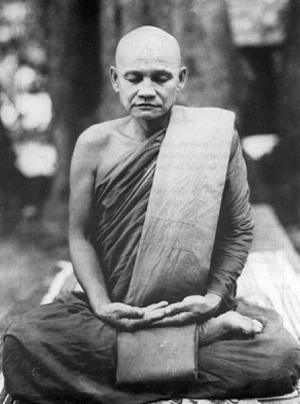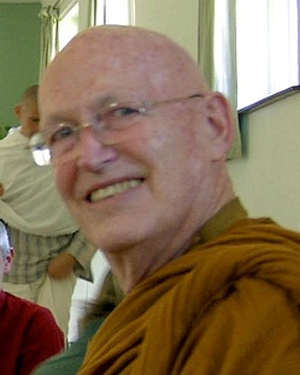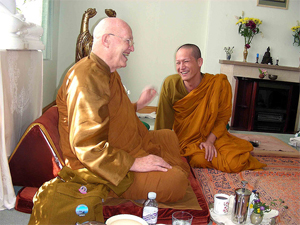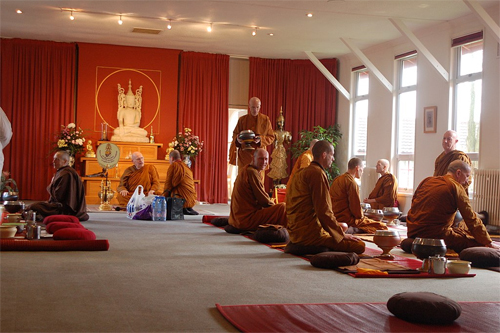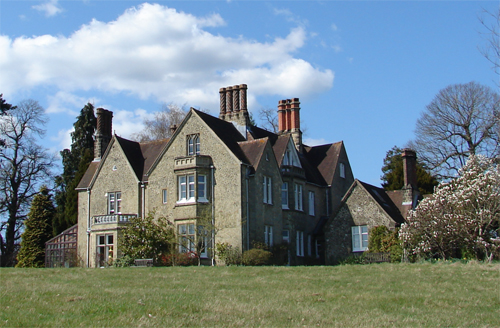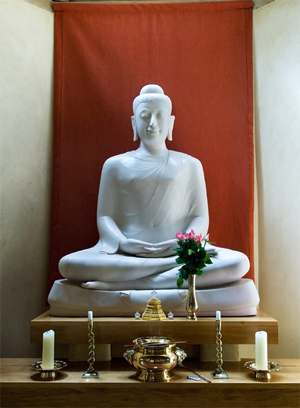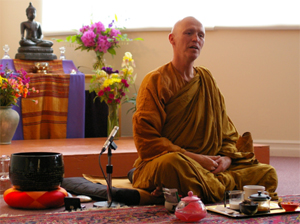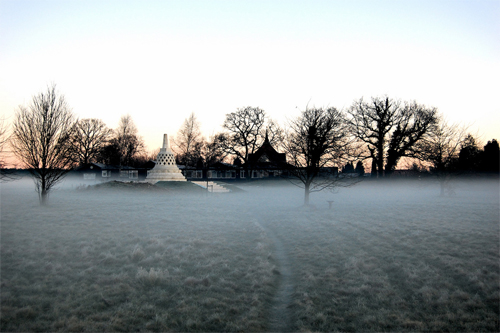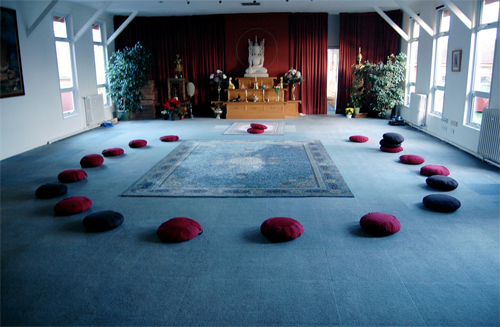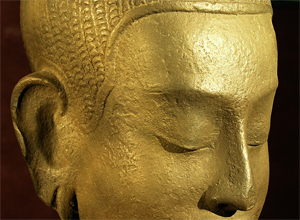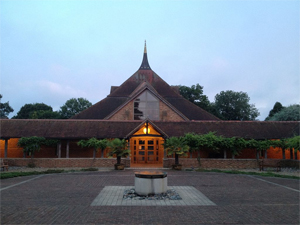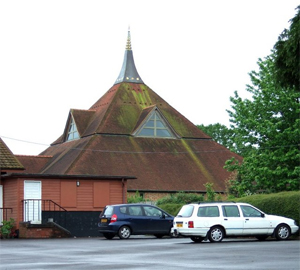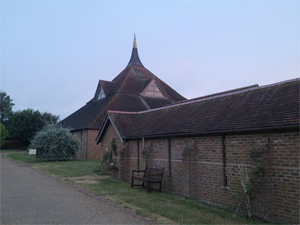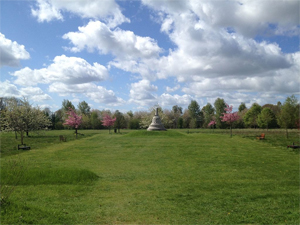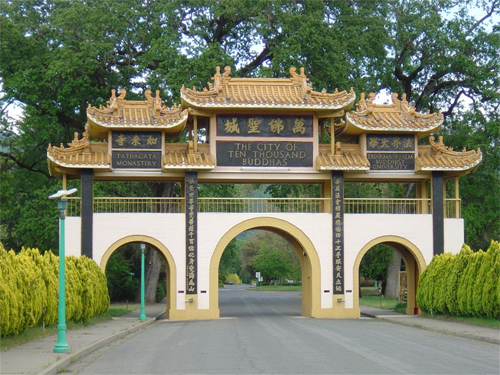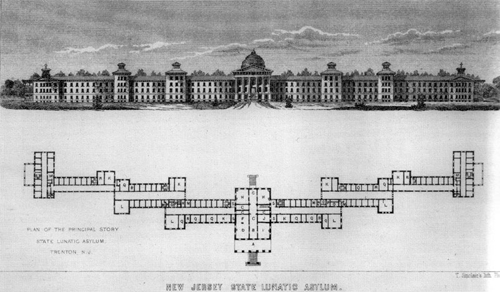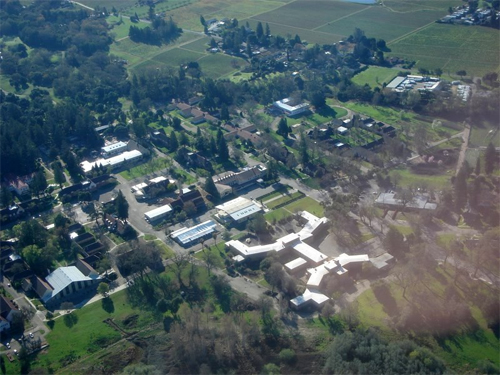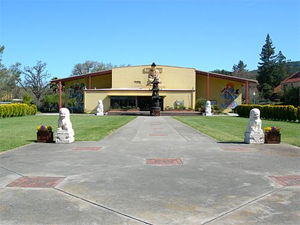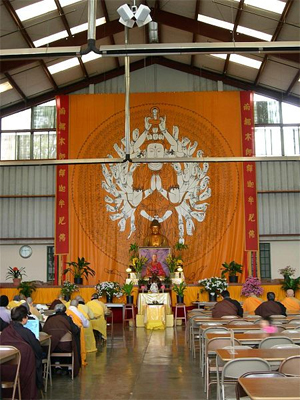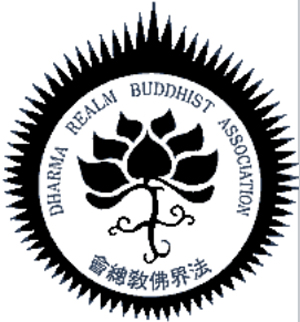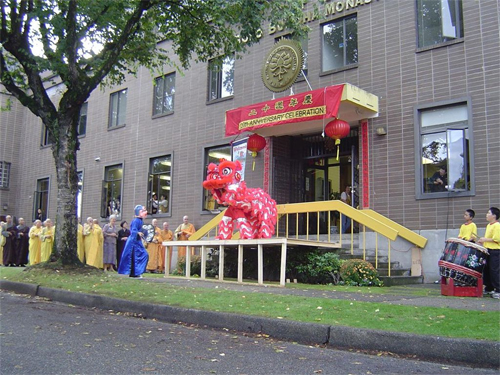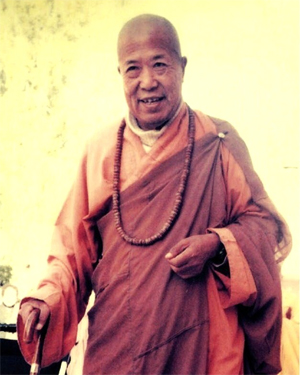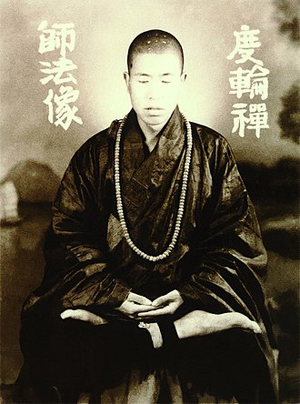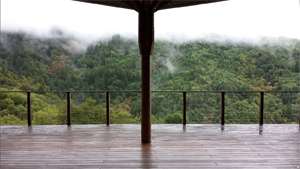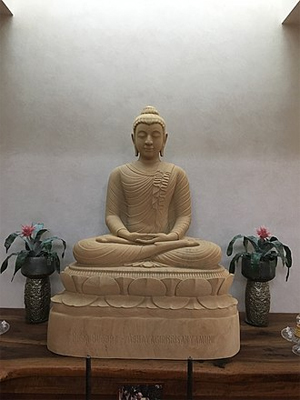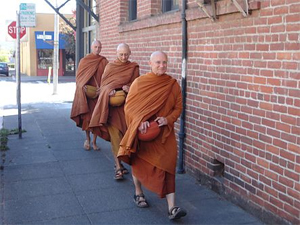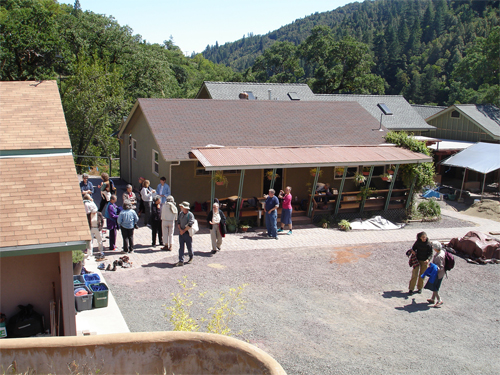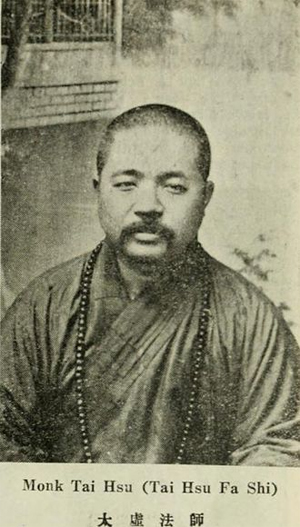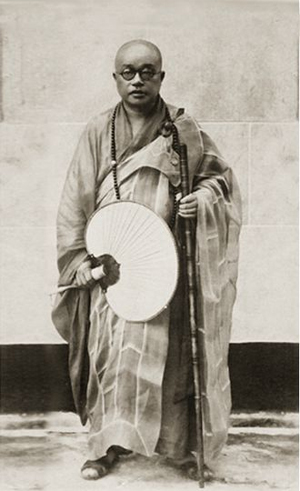by Wikipedia
Accessed: 8/9/20
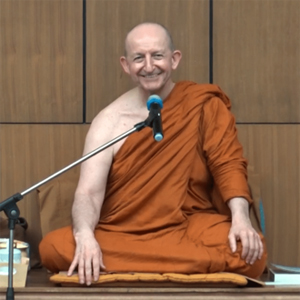
Ajahn Amaro
Ajahn Amaro in Bangkok in June 2019
Personal
Born: Jeremy Charles Julian Horner, 2 September 1956 (age 63), Kent, England
Religion Buddhism
Nationality British/American
School: Theravāda
Lineage: Thai Forest Tradition
Education: Bedford College, London (BSc)
Order: Maha Nikaya
Senior posting
Teacher: Ajahn Chah
Ordination: 1979 (41 years ago)
Previous post: Co-Abbot of Abhayagiri Buddhist Monastery (1996–2010)
Present post: Abbot of Amaravati Buddhist Monastery (since 2010)
Website: amaravati.org
Ajahn Amaro (born 1956)[1] is a Theravāda Buddhist monk and teacher, and abbot of the Amaravati Buddhist Monastery at the eastern end of the Chiltern Hills in South East England.
Amaravati is a Theravada Buddhist monastery at the eastern end of the Chiltern Hills in South East England. Established in 1984 by Ajahn Sumedho as an extension of Chithurst Buddhist Monastery, the monastery has its roots in the Thai Forest Tradition.Cittaviveka (Pali: 'discerning mind'), commonly known as Chithurst Buddhist Monastery, is an English Theravada Buddhist Monastery in the Thai Forest Tradition. It is situated in West Sussex, England in the hamlet of Chithurst between Midhurst and Petersfield. It was established in 1979 in accordance with the aims of the English Sangha Trust, a charity founded in 1956 to support the ordination and training of Buddhist monks (bhikkhus) in the West. The current abbot, since 2014, is Ajahn Karuniko.
The monastery was established by Ajahn Sumedho under the auspices of his teacher, Ajahn Chah of Wat Pah Pong, Ubon, Thailand. Ajahn Chah visited the monastery at its inception as the first branch monastery of Wat Pah Pong to be established outside of Thailand. Although the style of the monastery has been modified to accommodate Western social and cultural mores, it retains close links with Thailand especially monasteries of the Thai Forest Tradition and is supported by an international community of Asians and Westerners.
"Cittaviveka" is a term used in the Pāli scriptures of Theravada Buddhism. The monastery was so named by Ajahn Sumedho, the first abbot (1979–1984) as a suitable word-play on "Chithurst," the hamlet in which its main house is situated. The title "Chithurst Buddhist Monastery" is also commonly used, although the approximately 175 acres/70 hectares of the monastery’s land extend into the adjacent parish.
Subsequent abbots have been Ajahn Ānando (1984–1992), Ajahn Sucitto (1992-2014) and Ajahn Karuniko (2014-). The monastery is supported by donations, and lay people may visit or stay for a period of time as guests free of charge. Teachings are given on a regular basis, generally on weekends.
-- Chithurst Buddhist Monastery, by Wikipedia
It takes inspiration from the teachings of the community's founder, the late Ajahn Chah. Its chief priorities are the training and support of a resident monastic community, and the facilitation for monastic and lay people alike of the practice of the Buddha's teachings.
It is not to be confused with the ancient Amaravati Stupa in India.
-- Amaravati Buddhist Monastery, by Wikipedia
The centre, in practice as much for ordinary people as for monastics, is inspired by the Thai Forest Tradition and the teachings of the late Ajahn Chah.[1] Its chief priorities are the practice and teaching of Buddhist ethics, together with traditional concentration and insight meditation techniques, as an effective way of dissolving suffering.
Chah Subhaddo (Thai: ชา สุภัทโท, known in English as Ajahn Chah, occasionally with honorific titles Luang Por and Phra) also known by his honorific name "Phra Bodhiñāṇathera" (Thai: พระโพธิญาณเถร, Chao Khun Bodhinyana Thera; 17 June 1918 – 16 January 1992) was a Thai Buddhist monk. He was an influential teacher of the Buddhadhamma and a founder of two major monasteries in the Thai Forest Tradition.
Respected and loved in his own country as a man of great wisdom, he was also instrumental in establishing Theravada Buddhism in the West. Beginning in 1979 with the founding of Cittaviveka (commonly known as Chithurst Buddhist Monastery) in the United Kingdom, the Forest Tradition of Ajahn Chah has spread throughout Europe, the United States and the British Commonwealth. The dhamma talks of Ajahn Chah have been recorded, transcribed and translated into several languages.
More than one million people, including the Thai royal family, attended Ajahn Chah's funeral in January 1993 held a year after his death due to the "hundreds of thousands of people expected to attend". He left behind a legacy of dhamma talks, students, and monasteries.
-- Ajahn Chah, by Wikipedia
Biography
Ajahn Amaro was born J. C. Horner[2] in Kent. He was educated at Sutton Valence School and Bedford College, University of London. Ajahn means teacher. He is a second cousin of I.B. Horner (1896–1981), late President of the Pali Text Society.[3][4]
Apart from a certain interest in the theories of Rudolf Steiner—to which he had been introduced by Trevor Ravenscroft,[2] Amaro's principal enthusiasms on leaving university were, by his own admission, pretty much those standard-issue among sceptical students of the day: sex, drugs and rock'n'roll.
Having completed his honours degree in psychology and physiology,[2] in 1977 he went to Malaysia, Indonesia and Thailand on an undefined "open-ended" spiritual search. He somehow found himself in northeast Thailand, at the forest monastery of Wat Pah Nanachat.
Wat Pah Nanachat (Thai: วัดป่านานาชาติ; Bung Wai International Forest Monastery) is a Thai Theravada Buddhist Monastery in northeast Thailand about 15 kilometres from the city of Ubon Rachathani. It was established in 1975 by Ajahn Chah as a training community for non-Thais according to the norms of the Thai Forest Tradition. Resident monks, novices and postulants include a wide range of nationalities. The primary language of communication and instruction is English.
The monastery was founded in response to increasing international interest, particularly from the United Kingdom, in the Theravadin forest tradition of Thailand. The first abbot of Wat Pah Nanachat was Ajahn Sumedho, an American bhikkhu trained by Ajahn Chah at Wat Nong Pah Pong, the mother house of Wat Pah Nanachat.Luang Por Sumedho or Ajahn Sumedho (Thai: อาจารย์สุเมโธ) (born Robert Karr Jackman, July 27, 1934) is one of the senior Western representatives of the Thai forest tradition of Theravada Buddhism. He was abbot of Amaravati Buddhist Monastery, UK, from its consecration in 1984 until his retirement in 2010. Luang Por means Venerable Father (หลวงพ่อ), an honorific and term of affection in keeping with Thai custom; ajahn means teacher. A bhikkhu since 1967, Sumedho is considered a seminal figure in the transmission of the Buddha's teachings to the West.
Ajahn Sumedho was born Robert Karr Jackman in Seattle, Washington, in 1934. During the Korean War he served for four years from the age of 18 as a United States navy medic. He then did a BA in Far Eastern studies and graduated in 1963 with an MA in South Asian studies at the University of California, Berkeley. After a year as a Red Cross social worker, Jackman served with the Peace Corps in Borneo from 1964 to 1966 as an English teacher. On break in Singapore, sitting one morning in a sidewalk café, he watched a Buddhist monk walk by and thought to himself, "That looks interesting." In 1966, he became a novice or samanera at Wat Sri Saket in Nong Khai, northeast Thailand. He ordained as a bhikkhu (Buddhist monk) in May the following year.
From 1967-77 at Wat Nong Pah Pong, he trained under Ajahn Chah. He has come to be regarded as the latter's most influential Western disciple. In 1975, he helped to establish and became the first abbot of the International Forest Monastery, Wat Pa Nanachat in northeast Thailand founded by Ajahn Chah for training his non-Thai students. In 1977, Ajahn Sumedho accompanied Ajahn Chah on a visit to England. After observing a keen interest in Buddhism among Westerners, Ajahn Chah encouraged Ajahn Sumedho to remain in England for the purpose of establishing a branch monastery in the UK. This became Cittaviveka Forest Monastery in West Sussex.
Ajahn Sumedho was granted authority to ordain others as monks shortly after he established Cittaviveka Forest Monastery. He then established a ten precept ordination lineage for women, "Siladhara".
Until his retirement, Ajahn Sumedho was the abbot of Amaravati Buddhist Monastery near Hemel Hempstead in England, which was established in 1984. Amaravati is part of the network of monasteries and Buddhist centres in the lineage of Ajahn Chah, which now extends across the world, from Thailand, New Zealand and Australia, to Europe, Canada and the United States. Ajahn Sumedho played an instrumental role in building this international monastic community.
Ajahn Sumedho's imminent retirement was announced in February 2010, and he retired in November of that year. His successor is the English monk Ajahn Amaro, hitherto co-abbot of the Abhayagiri branch monastery in California's Redwood Valley. Ajahn Sumedho now dwells as a "free agent" in Thailand.
-- Ajahn Sumedho, by Wikipedia
Today, as a consequence, students of the Thai forest tradition are found in branch monasteries around the world under the collective label of The Forest Sangha. The largest monastery of this network is Amaravati Monastery, about 30 miles north of London. Its abbot was Ajahn Sumedho, who recently relinquished the post to Ajahn Amaro (ex-co-abbot of Abhayagiri Buddhist Monastery in California).
Buddhist meditation practice of all types is encouraged at Wat Pananachat, though breathing meditation predominates. In the spirit of Ajahn Chah's teachings, vipassanā, or insight, and samatha, or concentration, are regarded as two sides of a coin rather than two distinct categories. Lay visitors are expected to observe the eight precepts version of sila, or the practice of virtue. For monks, strict adherence to the Vinaya, the 2,500-year-old code of discipline, is not only required but is the distinguishing characteristic of the lineage. For lay visitors, no formal meditation teaching is available beyond Dhamma talks and what may be derived from freely available reading matter, the priority being the formal training of the full-time mendicants.
-- Wat Pah Nanachat, by Wikipedia
Ajahn Chah's charismatic impact and the encouragement of the senior American monk Ajahn Pabhakaro were decisive.
Joseph Kappel lived as a Buddhist monk for 20 years as Bhikkhu Pabhakaro, with Ajahn Chah and Ajahn Sumedho in Thailand and Great Britain. His initial interest in Buddhism was inspired by visits to Thailand from Vietnam where he served as a combat helicopter pilot in 1969-70. During his sojourns to Thailand, Joseph was deeply moved by a country and people that were steeped in Buddhist teachings. In short, combat in Vietnam paved the way for him to embrace a way of life that leads us on a path that demonstrates how suffering is created and how to avoid it. In this way, we open our eyes to witness ourselves in others with compassion and understanding.
Since leaving monastic life in 1991, Joseph has taught MBSR (Mindfulness Based Stress Reduction) in Massachusetts’s prisons, received a Masters Degree in Education from Harvard University, and worked with college athletes to facilitate “mental fitness” and the inner game. He has also led meditation courses and retreats in numerous settings in the US, and has co-led retreats with Ajahn Amaro at Amaravati Buddhist Monastery in England. Joseph and his wife Catherine live in Leominster, Massachusetts.
-- Joseph Kappel, by Buddhadasa Indapanno Archives
It changed his life. Having become a lay renunciate, four months later he became a novice and in 1979 he received upasampada from Ajahn Chah and took profession as a Theravadin bhikkhu.[1] He stayed in Thailand for two years. Amaro then went back to England to help Ajahn Sumedho establish Chithurst Monastery in West Sussex.[1] With the blessing of his abbot, in 1983 he moved to Harnham Vihara in Northumberland. He made the entire 830-mile journey on foot, chronicled in his 1984 volume Tudong: The Long Road North.[5][6]
Origins of California's Abhayagiri Monastery
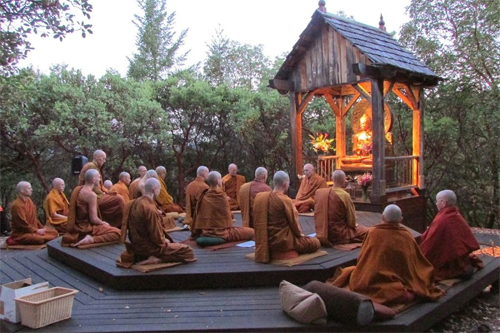
Abhayagiri Monastery
In the early 1990s Amaro made several teaching trips to northern California. Many who attended his meditation retreats became enthusiastic about the possibility of establishing a permanent monastic community in the area.
Amaravati, his mother house back in England, meanwhile received a substantial donation of land in Mendocino County from Chan Master Hsuan Hua, founder of the City of Ten Thousand Buddhas in Talmage. The land was allocated to establish a forest retreat. Since for some years Ajahn Sumedho had venerated the Chinese master, both abbots hoped that, among its other virtues, the center would serve as a symbolic bond between the otherwise distinct Theravāda and Mahayana lineages.
Hsuan Hua (Chinese: 宣化; pinyin: Xuānhuà; lit.: 'proclaim and transform'; April 16, 1918 – June 7, 1995), also known as An Tzu and Tu Lun, was a monk of Chan Buddhism and a contributing figure in bringing Chinese Buddhism to the United States in the 20th century.
Hsuan Hua founded several institutions in the US. The Dharma Realm Buddhist Association[1] (DRBA) is a Buddhist organization with chapters in North America, Australia and Asia.The Dharma Realm Buddhist Association (shortened to DRBA, Chinese: 法界佛教總會, PY: Fajie Fuojiao Zonghui, formerly known as the Sino-American Buddhist Association) is an international, non-profit Buddhist organization founded by the Venerable Master Hsuan Hua in 1959 to bring the orthodox teachings of the Buddha to the entire world. DRBA has branch monasteries in many countries and cities, including San Francisco, Los Angeles, Seattle, and Vancouver, as well as in Malaysia, Taiwan, Hong Kong, and Australia.
The Sino-American Buddhist Association was founded in San Francisco, California in 1959. A small temple, the Buddhist Lecture Hall was started. The Venerable Master Hsuan Hua came over from Hong Kong in 1962 by plane, stopping over at Japan and Hawaii before arriving at San Francisco.
From 1962 to 1968 the Venerable Master lectured on the Lotus Sutra, the Diamond Sutra, and the Amitabha Sutra among many other Buddhist sutras and texts. Many of his Dharma talks and line-by-line explanations of sacred Buddhist texts have been published in book form by the Buddhist Text Translation Society, both in the original Chinese and in English translation. See TfM [failed verification]The Buddhist Text Translation Society (BTTS) is dedicated to making the principles of the Buddhadharma available to Western readers in a form that can be directly applied to practice. Since 1972, the Society has been publishing English translations of sutras, instructional handbooks on meditation and moral conduct, and biographies. Most of the Society’s sutra translations are accompanied by contemporary commentary, based on lectures spoken by Tripitaka Master Hsuan Hua.
The accurate and faithful translation of the Buddhist Canon into English and other Western languages is one of the primary objectives of the Dharma Realm Buddhist Association (DRBA), the parent organization of the Buddhist Text Translation Society. Translators, bilingual reviewers, English editors, and bilingual certifiers are anonymous members of BTTS.
When Buddhism first came to China from India, one of the most important tasks required for its establishment was the translation of the Buddhist scriptures from Sanskrit into Chinese. This work involved a great many people, such as the renowned monk National Master Kumarajiva (fifth century), who led an assembly of over 800 people to work on the translation of the Tripitaka (Buddhist canon) for over a decade. Because of the work of individuals such as these, nearly the entire Buddhist Tripitaka of over a thousand texts exists to the present day in Chinese.
Now the banner of the Buddha’s Teachings is being firmly planted in Western soil, and the same translation work is being done from Chinese into English. Since 1970, the Buddhist Text Translation Society has been making a paramount contribution toward this goal. Aware that the Buddhist Tripitaka is a work of such magnitude that its translation could never be entrusted to a single person, the BTTS, emulating the translation assemblies of ancient times, does not publish a work until it has passed through four committees for primary translation, revision, editing, and certification. The leaders of these committees are Bhikshus (monks) and Bhikshunis (nuns) who have devoted their lives to the study and practice of the Buddha’s teachings. For that reason, all of the works of the BTTS emphasize the application of the Buddha’s teachings in terms of actual practice.
-- About the Buddhist Text Translation Society, by Buddhist Text Translation Society
In June 1968 he began a 96-day intensive Study and Practice Summer Session for students and faculty from the University of Washington in Seattle. After the session had concluded, many of the participants remained in San Francisco to continue their studies with the Venerable Master. In that year five Americans (three Bhikshus, two Bhikshunis) were ordained, marking the beginning of the Sangha in the United States.
In 1970 Gold Mountain Monastery, one of the first Chinese Buddhist temples in the United States was founded in San Francisco, and a Hundred Day Chan Session was begun. Vajra Bodhi Sea, a monthly journal of DRBA about Buddhist topics and teachings, was also founded in 1970.
In 1972 the first Threefold Ordination Ceremony for the transmission of the complete precepts was held at Gold Mountain Monastery.
In 1973 the Institute for the Translation of Buddhist Texts and Instilling Goodness Elementary School were founded in San Francisco. In the same year, Bhikshus Heng Ju and Heng Yo began a Three Steps One Bow pilgrimage from San Francisco to Seattle to pray for world peace - a hard journey over 1,000 miles. This was the first such pilgrimage in the history of American Buddhism.
The site of the City of Ten Thousand Buddhas was purchased in 1974, and in November of that year the Venerable Master Hsuan Hua led a delegation to propagate the Dharma in Hong Kong, India, Singapore, Vietnam, Taiwan and other places. The delegation lasted for three months, ending on January 12, 1975.The Dharma Realm Buddhist Association purchased the City of Ten Thousand Buddhas site in 1974 and established an international center there by 1976. In 1979, the Third Threefold Ordination Ceremony at the City of Ten Thousand Buddhas was held, in which monks from China, Vietnam, Sri Lanka and the US transmitted the precepts. It was considered unique, as it represented both the Mahayana and Theravada traditions.
Originally the site housed the Mendocino State Asylum for the Insane (later renamed the Mendocino State Hospital), founded in 1889. There were over seventy large buildings, over two thousand rooms of various sizes, three gymnasiums, a fire station, a swimming pool, a refuse incinerator, fire hydrants, and various other facilities. A paved road wound its way through the complex, lined with tall street lamps and trees planted during the asylum's initial construction. The connections for electricity and pipes for water, heating, and air conditioning were all underground, but centrally controlled.
Considering the natural surroundings to be ideal for cultivation, Hsuan Hua visited the valley three times and negotiated with the seller many times. He wanted to establish a center for propagating the Buddhadharma throughout the world and for introducing the Buddhist teachings, which originated in the East, to the Western world. Hsuan Hua planned to create a major center for world Buddhism, and an international orthodox monastery for the purpose of elevating moral standards and raising people's awareness.
The city comprises 488 acres (197 hectares) of land, of which 80 acres (32 hectares) are developed. The rest of the land includes meadows, orchards, and forests. Large institutional buildings and smaller residential houses are scattered over the west side of the campus. The main Buddha hall, monastic facilities, educational institutes, administrative offices, the main kitchen and dining hall, Jyun Kang Vegetarian Restaurant, and supporting structures are all located in this complex.
-- City of Ten Thousand Buddhas, by Wikipedia
Gold Wheel Monastery was founded in Los Angeles in 1975.
In 1976 the City of Ten Thousand Buddhas completed the second Threefold Ordination Ceremony. Developing Virtue Secondary Schools and Dharma Realm Buddhist University were also founded. The next year Dharma Masters Heng Sure[2] and Heng Chau began a second Three Steps, One Bow pilgrimage from Gold Wheel Monastery to the City of Ten Thousand Buddhas.
-- Dharma Realm Buddhist Association, by Wikipedia
The City of Ten Thousand Buddhas (CTTB) in Ukiah, California, is one of the first Chan Buddhist monasteries in America. Venerable Master Hsuan Hua founded Dharma Realm Buddhist University at CTTB. The Buddhist Text Translation Society works on the phonetics and translation of Buddhist scriptures from Chinese into English, Vietnamese, Spanish, and many other languages.
-- Hsuan Hua, by Wikipedia
Care for what became Abhayagiri was placed in the hands of a group of lay practitioners, the Sanghapala Foundation.[6]
Abhayagiri, or Fearless Mountain in the canonical language of Pali, is a Theravadin Buddhist monastery of the Thai Forest Tradition in Redwood Valley, California. Its chief priorities are the teaching of Buddhist ethics, together with traditional concentration and insight meditation (also known as the Noble Eightfold Path), as an effective way of completely uprooting suffering and discontent.
About 16 miles (26 km) north of Ukiah, the monastery has its origins in the 1980s when the UK-based Ajahn Sumedho, foremost western disciple of the Thai meditation master Ajahn Chah, started getting requests to teach in California. Visits by Ajahn Sumedho, as well as other senior monks and nuns, resulted in the Sanghapala Foundation being set up in 1988. The monastery's first 120 acres (0.49 km2) were given to the foundation by the devotees of Chan Master Hsuan Hua, founder of the City of Ten Thousand Buddhas in Talmage, before he died in 1995. Currently, the monastery rests on 280 acres (1.1 km2) of mountainous forest land.
Six months after the monastery was settled by Ajahn Amaro, Ajahn Pasanno arrived to join him as co-abbot. They served together in this role until July, 2010, when Ajahn Amaro departed to take up the invitation to serve as abbot of Amaravati Buddhist Monastery in England. Ajahn Pasanno was the sole abbot of Abhayagiri between July, 2010 and July, 2018.[4]
Abhayagiri Monastery developed significantly under Ajahn Pasanno's and Ajahn Amaro's leadership and guidance, along with the support of the monastic and lay community, and more specifically, the Abhayagiri Building Committee. Over 25 kutis, monastic huts, were built in the mountainous monastery forest during their time as co-abbots as well as when Ajahn Pasanno was the lone abbot. In addition, during the early years, the co-abbots converted both current and new buildings into a Dhamma Hall, kitchen, office spaces, a room for disabled visitors, a laundry room and bathrooms/showers for lay women and men, along with monastery infrastructure and extensive creation of forest paths and roads.
The co-abbots also contributed to the building of the Bhikkhu Commons, more affectionately know to the residents as the MUB: Monks' Utility Building, a 1600 square foot complex located in the upper forest of the monastery. The MUB offers monks access to bathrooms, showers, a multipurpose meeting room, a large sewing room, a laundry room, a small kitchenette and a large storage room below. The MUB was dedicated and officially opened on July 4, 2010...
As of July 2018, there were two abbots (co-abbots), a total of 13 fully ordained bhikkhus (Buddhist monks), two samaneras (novices), and 4 anagarikas (postulants) and a long term female monastic resident. Men and women live in separate locations in the monastery following guidelines of formal celibacy. Male residents live in small huts nestled in the forest. Female residents live in a house and a couple of huts on an adjoining property which was separately donated for the purpose of housing women at the monastery. Guest teachers come from forest monasteries in Thailand, England, as well as other countries in Europe and Australia. Visitors come to the monastery regularly for day visits, and can also stay as overnight guests.
The daily schedule, in keeping with tradition, is rigorous. Most residents (monastics and lay visitors) rise well before sunrise. Morning puja begins at 5:00 am and lasts an hour and a half. It includes chanting in both Pali and English, as well as an hour of silent meditation. This is followed by a half-hour chore period and a simple oatmeal breakfast. At 7:30 am, there is a meeting where a short Dhamma reflection is given and work assignments for the morning period are announced. A three-hour work period follows this meeting, ending with a meal around 11:00 am, which has to be consumed before midday. All lay residents follow the 8 precepts which include not eating food after noon until dawn the next day. Around 1:00 pm, after the post-meal cleanup, the schedule is open for individual practice of sitting and walking meditation as well as Dhamma study. It is at this time that monks, in addition to their meditation and study practice, care for their personal requisites like the huts they live in and the robes they wear. One can also walk around the extensive network of trails that wind about the mountainside. At 5:30 pm, tea is served in the kitchen and on most days one of the Ajahns is available in the Dhamma Hall for questions and answers. Tea time is followed by the evening puja beginning at 7:00 pm, which includes chanting in Pali and another hour of silent meditation. Formal Dhamma talks are offered on Saturday evening and lunar observance days during evening puja just after the period for silent meditation. On lunar observance days, which mark the four moon quarters, sitting and walking meditation continue until 3:00 am the next morning, followed by a morning puja.
-- Abhayagiri Buddhist Monastery, by Wikipedia
Mission: To foster and promote the teachings of the Buddha by supporting a resident community of Buddhist monks.
Program 1: Operate Buddhist monastery where 15 to 20 monastics reside at any one time. Provide training in the Buddhist religion to monastery residents and guests. Hold regular religious services at the monastery. Provide conditions suitable for extended meditation and contemplation for residents and guests of the monastery. Provide teachings by senior monastics throughout Northern California and around the world. Maintain website which includes teachings and recorded talks.
Expenses: $339,987
Revenue: $0
Ruling Year: 1996
Principal Officer: MARK A SPONSELLER
Main Address: 16201 Tomki Rd
Redwood Valley, CA 95470
EIN: 94-3212705
-- Sanghapala Foundation, by guidestar.org
Ajahn Pasanno was appointed founding co-abbot of Abhayagiri with Ajahn Amaro. The latter announced on 8 February 2010 that he would be leaving Abhayagiri and returning to England, having accepted a request from Ajahn Sumedho to succeed him as abbot at Amaravati.[7]
Thai honorific ranks
• 5 December 2015 – Phra Videsabuddhiguṇa (พระวิเทศพุทธิคุณ)[8]
• 28 July 2019 – Phra Raj Buddhivaraguṇa Vipulasasanakiccadara Mahaganissara Pavarasangharama Gamavasi (พระราชพุทธิวรคุณ วิบูลศาสนกิจจาทร มหาคณิสสร บวรสังฆาราม คามวาสี)[9][10]
Bibliography
• Tudong: The Long Road North (1984, English Sangha Trust)
• Silent Rain (1994, Amaravati Publications)
• Words of Calm and Friendship – by Ajahn Pasanno & Ajahn Amaro (1999, Abhayagiri Monastery)
• The Pilgrim Kamanita: A Legendary Romance – by Karl Gjellerup, Ajahn Amaro ed. (1999, Amaravati Publications)
• The Dhamma and the Real World – by Ajahn Pasanno & Ajahn Amaro (2000, Abhayagiri Monastery)
• Broad View, Boundless Heart – by Ajahn Pasanno & Ajahn Amaro (2001, Abhayagiri Monastery)
• Food for the Heart – by Ven. Ajahn Chah; Introduction by Ajahn Amaro (2002, Wisdom Publications)
• Small Boat, Great Mountain: Theravadin Reflections on the Natural Great Perfection (2003, Abhayagiri Monastery)
• Who Will Feed the Mice? (2004, Abhayagiri Monastery)
• The Sound of Silence – by Ven. Ajahn Sumedho; Introduction by Ajahn Amaro (2007, Wisdom Publications)
• Rugged Interdependency (2007, Abhayagiri Monastery)
• Like a River – by Ajahn Pasanno, Ajahn Amaro et al. (2008, Patriya Tansuhaj)
• The Island: An Anthology of the Buddha's Teachings on Nibbāna (2009, Abhayagiri Monastery) – by Ajahn Pasanno & Ajahn Amaro
• Rain on the Nile (2009, Abhayagiri Monastery)
• The Long Road has Many a Turn – by Nick Scott with Ajahn Amaro (2013, Amaravati Publications)
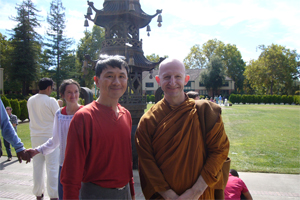
Ajahn Amaro at the City of Ten Thousand Buddhas in September 2007
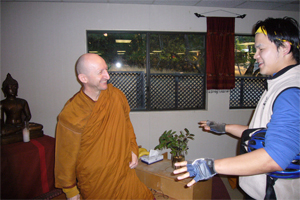
Ajahn Amaro in California with Franklyn, organiser of the 2007 Buddhist Bicycle Pilgrimage
References
1. "Ajahn Amaro". Spirit Rock Meditation Center. Retrieved 10 September 2019.
2. Talbot, Mary (Winter 1998). "Just Another Thing in the Forest". Tricycle: The Buddhist Review. Retrieved 10 September 2019.
3. "Ajahn Amaro: "Buddhism and Mindfulness in the West: Where are They Headed and What Challenges Do They Face?"". The Ho Center for Buddhist Studies. Retrieved 10 September 2019.
4. Amaro, Ajahn (2014). "I B Horner – Some Biographical Notes" (PDF). Sati Journal. Sati Center for Buddhist Studies. 2 (1): 33–38. ISBN 978-1495260049. Retrieved 10 September 2019.
5. Kiely, Robert, His Holiness the Dalai Lama (1996). The Good Heart: A Buddhist Perspective on the Teachings of Jesus. Wisdom Publications. p. 205. ISBN 0-86171-114-9.
6. Seager, Richard Hughes (2000). Buddhism in America. Columbia University Press. p. 155. ISBN 0-231-10868-0.
7. Amaro announces departure from Abayagiri
8. ราชกิจจานุเบกษา, ประกาศสํานักนายกรัฐมนตรี เรื่อง พระราชทานสัญญาบัตรตั้งสมณศักดิ์พระสงฆ์ในต่างประเทศ, เล่ม 132, ตอนที่ 33 ข, 4 ธันวาคม 2558, หน้า 56
9. ราชกิจจานุเบกษา, พระบรมราชโองการประกาศ เรื่อง พระราชทานสัญญาบัตรตั้งสมณศักดิ์, เล่ม 136, ตอนที่ 40 ข, 28 กรกฎาคม 2562 , หน้า 13
10. Dibdin, Cara (14 August 2019). "Thai King Bestows High Honor on Western Buddhists". Tricycle: The Buddhist Review. Retrieved 22 August 2019.

